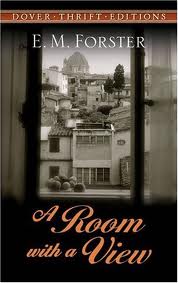A Room With a View by E.M. Forster
Reviewed by Ellen

Author: E.M. Forster
Ratings Explanation
Violence: Two Italian men fight in a square, and while Lucy watches, one stabs the other, who dies right before her eyes. Blood spews from his mouth onto the sidewalk. Lucy faints.
Sexual Content: On a trip by carriage into the Italian countryside, the driver, a young man, kisses and fondles his female companion. George kisses Lucy passionately in a field of violets. Cecil and Lucy kiss awkwardly. George kisses Lucy again behind the bushes of her home. George, Freddy, and Mr. Beebe go for a “bathe” (skinny-dipping) in a pond, and Lucy, Cecil, and Mrs. Honeychurch stumble upon them unexpectedly. Lucy sees George without his clothes on.
Synopsis
A Room With a View is one of E.M. Forster’s most celebrated and light-hearted novels. First published in 1908, the book explores love, passion, and propriety as it confronts Lucy Honeychurch, a young woman of Edwardian-era England. Lucy is proper and demure on a visit to an Italian pensione with her cousin and chaperone, Charlotte Bartlett. The one thing she does passionately is play the piano, but even when wrapped up in Beethoven, “she struck no more right notes than was suitable for one of her age and situation.” When she faints and falls into the arms of George Emerson after witnessing a murder in a Florentine piazza, she cannot deny her attraction to him although he is entirely unsuitable for her (he is but a lowly railroad clerk). Back home in Surrey, she becomes engaged to Cecil Vyse, a stuffy, arrogant suitor with “depths of prudishness in him” who sums up his own character in these words, “There are some chaps who are no good for anything but books; I plead guilty to being such a chap.” But as fate would have it, the Emersons move into the neighborhood and she must face the improper but passionate young George again. Soon Lucy realizes she must choose between convention and passion, between propriety and love, and follow her heart.
This is one of my favorite books. Its colorful and quirky characters, clever dialogue, and amusing observations on human nature make it a delightful read. Forster’s gift was in illustrating characters who feel real with their little blemishes and oddities. There are nervous old maids, observant bachelor clergymen, tiresome relatives. A favorite line from this book: “Mistrust all enterprises that require new clothes” (painted on the cornice of a wardrobe belonging to Mr. Emerson).







